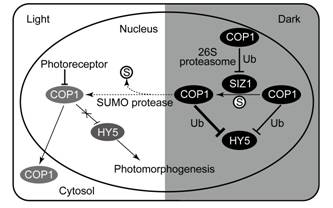Photomorphogenesis is an important plant developmental process in response to light. COP1, a ubiquitin E3 ligase, is a central negative regulator of photomorphogenesis. In darkness, the ubiquitin E3 ligase COP1 accumulates in the nucleus and mediates ubiquitination and degradation of positive regulators of photomorphogenesis. In response to light, COP1 activity is reduced to ensure proper photomorphogenic development. However, post-translational modifications that regulate COP1 activity are largely unknown.
Dr. JIN Jingbo’s lab at Institute of Botany, Chinese Academy of Sciences, reported that SUMO E3 ligase, SIZ1, physically interacts with COP1 and meditates its SUMO modification. Biochemical and genetic analyses demonstrated that SUMO modification of COP1 enhances its E3 ubiquitin ligase activity. In response to the light, sumoylation level of COP1 is decreased, which may also contributes to the reduction of COP1 activity in the light. Moreover, COP1 mediates ubiquitination and 26S proteasome-dependent degradation of SIZ1 and this feedback repression may ensure the moderate levels of COP1 activity. These results demonstrate that SIZ1-mediated SUMO modification negatively regulates photomorphogenesis, maintains the homeostasis of COP1 activity, ensuing proper photomorphogenic development in changing light environment. The study established a post-translational regulatory modular consisting of SIZ1-mediated sumoylation and COP1-mediated ubiquitination that cooperatively regulates photomorphogenesis.
The paper entitled “An Arabidopsis SUMO E3 ligase, SIZ1, negatively regulates photomorphogenesis by promoting COP1 activity” has been published in PLoS Genetics on April 29, 2016 (doi: 10.1371/journal.pgen.1006016). LIN Xiaoli first authored the paper. This work is funded by the National Natural Science Foundation of China, the Ministry of Science and Technology of the People’s Republic of China and Chinese Academy of Science.
Article link:http://www.ncbi.nlm.nih.gov/pubmed/27128446

Figure 1: The siz1mutant seedlings display a cop1-like phenotype
(A) siz1-2 seedlings exhibit a short-hypocotyl phenotype.(B) Hypocotyl length of five-day-oldseedlings at the indicated fluence rates of lights. (C) The enhanced responsiveness of light-responsive genesin siz1-2 seedlings compared to those in the wild type. (D) siz1-2seedlings exhibit unfolded apical hooks under dark conditions. (E) siz1-2 seedlings show more opened cotyledon compared to Col-0.

Figure 2:Proposed model of how SIZ1 and COP1 regulate photomorphogenesis
CONTACT INFO:
Prof. JIN Jingbo
Key Laboratory of Plant Molecular Physiology
Institute of Botany,
Chinese Academy of Sciences,
20 Nanxincun, Xiangshan, Beijing 100093, China
E-mail: jinjb@ibcas.ac.cn
Photomorphogenesis is an important plant developmental process in response to light. COP1, a ubiquitin E3 ligase, is a central negative regulator of photomorphogenesis. In darkness, the ubiquitin E3 ligase COP1 accumulates in the nucleus and mediates ubiquitination and degradation of positive regulators of photomorphogenesis. In response to light, COP1 activity is reduced to ensure proper photomorphogenic development. However, post-translational modifications that regulate COP1 activity are largely unknown.
Dr. JIN Jingbo’s lab at Institute of Botany, Chinese Academy of Sciences, reported that SUMO E3 ligase, SIZ1, physically interacts with COP1 and meditates its SUMO modification. Biochemical and genetic analyses demonstrated that SUMO modification of COP1 enhances its E3 ubiquitin ligase activity. In response to the light, sumoylation level of COP1 is decreased, which may also contributes to the reduction of COP1 activity in the light. Moreover, COP1 mediates ubiquitination and 26S proteasome-dependent degradation of SIZ1 and this feedback repression may ensure the moderate levels of COP1 activity. These results demonstrate that SIZ1-mediated SUMO modification negatively regulates photomorphogenesis, maintains the homeostasis of COP1 activity, ensuing proper photomorphogenic development in changing light environment. The study established a post-translational regulatory modular consisting of SIZ1-mediated sumoylation and COP1-mediated ubiquitination that cooperatively regulates photomorphogenesis.
The paper entitled “An Arabidopsis SUMO E3 ligase, SIZ1, negatively regulates photomorphogenesis by promoting COP1 activity” has been published in PLoS Genetics on April 29, 2016 (doi: 10.1371/journal.pgen.1006016). LIN Xiaoli first authored the paper. This work is funded by the National Natural Science Foundation of China, the Ministry of Science and Technology of the People’s Republic of China and Chinese Academy of Science.
Article link:http://www.ncbi.nlm.nih.gov/pubmed/27128446

Figure 1: The siz1mutant seedlings display a cop1-like phenotype
(A) siz1-2 seedlings exhibit a short-hypocotyl phenotype.(B) Hypocotyl length of five-day-oldseedlings at the indicated fluence rates of lights. (C) The enhanced responsiveness of light-responsive genesin siz1-2 seedlings compared to those in the wild type. (D) siz1-2seedlings exhibit unfolded apical hooks under dark conditions. (E) siz1-2 seedlings show more opened cotyledon compared to Col-0.

Figure 2:Proposed model of how SIZ1 and COP1 regulate photomorphogenesis
CONTACT INFO:
Prof. JIN Jingbo
Key Laboratory of Plant Molecular Physiology
Institute of Botany,
Chinese Academy of Sciences,
20 Nanxincun, Xiangshan, Beijing 100093, China
E-mail: jinjb@ibcas.ac.cn